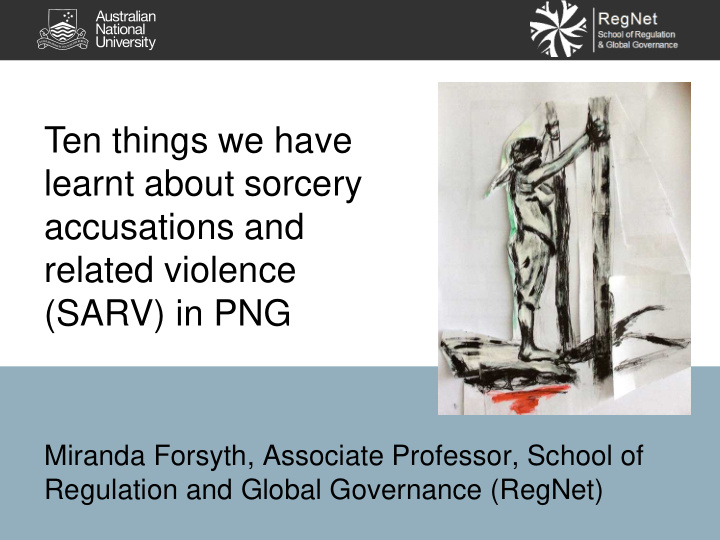



Ten things we have learnt about sorcery accusations and related violence (SARV) in PNG Miranda Forsyth, Associate Professor, School of Regulation and Global Governance (RegNet)
Acknowledge our large research team and donors This research initiative is part of the Papua New Guinea- Australia Partnership Father Philip Gibbs (Divine Word University, PNG), Dr Judy Putt (ANU), Dr Miranda Forsyth (ANU), Ms Llane Munau, Dr Sinclair Dinnen (ANU), Dr Fiona Hukula (National Research Institute, PNG) (Also Dr Ibolya Losoncz (ANU) and Phyllis Philip,Monica Kolkia (NRI), Fidelma Takaili (DWU) 2
What do I mean, sorcery?? Definitions/ terminology Sorcery/ witchcraft : potentially problematic and misleading English words used here to refer to a wide variety of belief systems/ worldviews whereby an individual (the “witch” or “sorcerer”) is considered able to cause harm through supernatural/ occult means. These beliefs vary enormously through PNG. 3
1. Characteristics of victims/survivors Are they really all old women? • Can be men or women, children or old people, and wealthy or people or poor people • Gendered depending on area • Multi-generational , eg recent Morobe case • Multiple secondary victims 4
2. Trends and quantities: 3 fieldsites • From 1 Jan 2016 – July 2018 we have recorded: – 97 cases in Enga and – 228 cases in Bougainville NB: each case often involves multiple victims, this includes accusations as well as violence • From 1 Jan 2017 – July 2018 we have recorded 72 cases in Port Moresby • Total 397 cases Ongoing significant problem, not just occasional event 5
2. Trends: Enga 2017 6
3. Multiple types of harm Visible and invisible, immediate and long term harm “and many deaths in the community, they relate back to sorcery. And women were the victims of torture of violence and women always live in fear ” (interviewee in Gorokoa) “ Sorcery violence has traumatized people, some lost body parts and are homeless. Most had their permanent houses burnt and chased from the village. Those who are homeless have relocated into the bush to build their lives again as the other communities would not accept them in fear of retaliation. Some have been locked up in jail [for their own protection].” ( Bougainville recorder ) 7
4. Catalysts of SARV It is caused by many things, not just one factor 8
5. Widespread confusion about the law Repeal of the Sorcery Act 1971 in 2013 widely misunderstood 9
6. Multiple justice responses State, non-state and hybrid justice systems actively manage SARV State justice response Non-state and hybrid • Multiple institutions • The State v John Kakiwi [2018] PGNC 273 , National Court, • “ The good thing about the Madang province, 24 July 2018: peace agreement court is – 8 sentenced to death penalty, 89 to life that, both parties are imprisonment for SARV • A further 3 wilful murder cases for present to share their SARV this year, resulting in side of the story. Both convictions for 14 men parties will share their stories and ask questions for the other to answer. ” (Bougainville recorder) 10
7. Many accusations are dealt with non-violently Who made attempts to deal with accusations in non-violent ways? (583 cases) 11
8. The importance of networked containment Fears of sorcery contained and non-violent responses modelled Both for intervention: Overall the cases in our database show the more people who intervene in a case, the less likely it is to lead to violence • Eg Simbu rapid response team And for prevention/ awareness • Eg Enga workshops with health workers, magistrates, police, Catholic youth leaders Image by and survivors Anton Lutz 12
9. Government agencies are making (some) progress Action despite non-funding of SARV National Action Plan • Maintaining the momentum through SARV NAP Committee regular meetings • Networks, linking in, incremental, collaborative approach • Establishment of provincial committees • Police training • CLRC church colloquiums • But non-funding of NAP and Police training workshop in Mt Hagen in mixed messages from March 2018 leaders about sorcery and who is responsible to address the problem 13
10. Emerging hypotheses for PNG research about what may counter such violence Structural, proximate and trigger factors all need addressing. But on top of that: • Multiple (but consistent and clear!) communication and awareness strategies and messages about no accusations and no violence • Strong leadership at multiple levels • Credible threats of state action, Eg/; issuing Above: New leaders of SNAP provincial preventative orders; publicising sentences committee in Enga; • Clarity around the law • Community driven by-laws and economic development • Rapid response teams, HRD networks • Medical evidence and good explanations about cause of death important but not sufficient
Recommend
More recommend